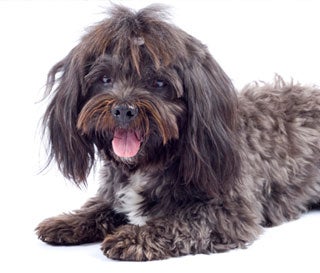Learn about dog breeds
Detailed information & photos on over 190 different breeds
Description
The Havanese dog is a small dog that does not have the same attitude and temperament as other toy breeds. You will find that this dog makes the perfect pet and a wonderful companion for the entire family.
The Havanese is a toy dog, which comes from Cuba. This dog is a popular family dog in Cuba and is known for being a lap dog for the aristocracy. Another use for this breed is to herd poultry because of their muscular and strong legs. This dog is part of the Bichon family and others in this breed include Bichon Frise and the Maltese.
The Havanese's coat is made to withstand warm temperatures and does not do well in the cold. The coat grows to a moderate length and needs to be brushed to keep from knotting. You can see that this toy dog is small, has a long neck, short muzzle, and broad nose. When these dogs get excited they jump up and down in a springing action before their front legs are shorter than their rear.
Coat Description
The Havanese is an easy dog to maintain because it has fine fur that does not shed. The fur is usually a silky texture and is thick to protect him from the harmful sun. Unfortunately, since these dogs originate in a warmer climate this dog is not protected from colder weather.
Fur on this dog grows 6-8 inches long and has a pearly appearance. The coat can be smooth, curly, and wavy. Most people like the wavy coat variety of the Havanese. Brushing needs to be done regularly or the fur will knot. Brushing is another great way to remove dander build up over time.
History
In the 1970s, a family from Cuba brought their Havanese to the US. The breed never really caught on and it is rare to find them. If you do find them you will most likely be put on a waiting list to purchase one and pay more than $2000.
This breed originated in Cuba. In the 17th Century, England brought Bichon lapdogs to Cuba. Due to the different climate, the dogs adapted and were called Blanquito de la Habana, which translates to Havanese Silk Dog. In the 19th Century, the French and German brought Poodles to the country. The poodles were bred with the Havanese Silk Dog and produced what the Havanese is today.
Temperament
The Havanese is friendly, loving and happy. These dogs love to play with their owners and other pets. They are intelligent and crave attention through doing stunts for others.
These dogs do not bark excessively like other toy dogs which makes them the ideal toy dog for the home. They do park at strangers until they get to know them. These dogs are not aggressive or territorial so they are a pleasure to have around and you will definitely have this pet around you because they love following their owner all over the house.
Health Problems
Like other pets, these dogs are susceptible to many different medical problems. In old age, this dog can suffer from cataracts. Dander seems to be a problem due to dry skin and sometimes need special medication to prevent this. Luxating patellas and PRA is also a common disease that is genetic. This occurs in the eyes and there is nothing to be done once the dog comes down with the disease. This causes the dog to go blind but it is not painful.
Grooming
With a coat that grows up to 8 inches this is a moderately long haired dog. The good news is that it does not shed like other dogs do twice or more a year. You will have to brush this dog's fur every week to make sure the hair doesn't become entangled. You can always cut the hair, which can make it easier to maintain. Be careful if you live in a colder setting because their coat is not made to withstand cold temperatures. In the summer, the Havanese does well.
Exercise
Exercise is important to every animal to prevent illness and health problems in old age. Make sure that your pup is getting a moderate amount of exercise each day. Running around the house is usually just as much as this pup needs since he is so small. Outside running is always a good treat for him as well.
Training
Training any type of pet means that you will have to spend some time with him every day. This is the only way to be consistent and help your pup know what's right and wrong. The Havanese is one of the easiest dogs to train but it still needs instruction.
These dogs love to make their owners happy and do everything they are told. Because of their intelligence they are able to be trained easily. A great game and skill to teach your Havanese is a search and find type of game. They have a great sense of smell, so if you hide a treat, they should be able to find it relatively easy.
Training must be done firmly with consistency. This is the best approach so your Havanese knows what it is expected to do. If you are housebreaking your puppy, you should be able to do it quickly. This puppy strives to make its owner happy and learns quickly what disappoints its master. For this reason, this dog also doesn't like to eat alone. You can expect that if your pup is eating and you leave the room, he will stop and follow you. Plan to have your meals in the accompaniment of your Havanese.
Advertise | Privacy Policy | Terms of Use | Contact Us © Copyright 2004-2024 PupCity.com. All rights reserved.
